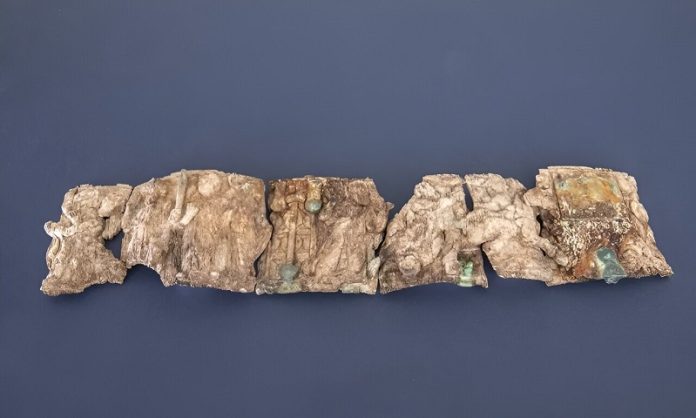
Since the summer of 2016, archaeologists from Innsbruck have been digging in an ancient hilltop settlement in southern Austria.
Two years ago, they made an amazing discovery: a Christian reliquary hidden in a previously unknown church. This reliquary contained an ancient ivory box, richly decorated with Christian symbols.
On August 4, 2022, a team led by archaeologist Gerald Grabherr found the incredible artifact in an early Christian church on the Burgbichl hill in Irschen, southern Austria.
The marble shrine, about 20 by 30 centimeters in size, was hidden under the altar in the side chapel area.
Inside the shrine was a heavily fragmented ivory box, known as a “pyx,” which was decorated with Christian motifs.
Normally, such relics are taken away as the “holiest” parts when a church is abandoned, but this one was left behind. It is the first pyx of its kind found in an archaeological context in Austria.
“There are about 40 known ivory boxes like this worldwide, and the last one found during excavations was about 100 years ago.
The few that exist are either in cathedral treasures or museums,” explained Gerald Grabherr.
Since its discovery, the 1,500-year-old ivory pyx has been conserved at the University of Innsbruck.
Ivory stored underground absorbs moisture, making it very soft and easily damaged. Uncontrolled drying can lead to shrinkage and cracks.
Ulrike Töchterle, head of the restoration workshop in Innsbruck, said, “The high humidity in the marble shrine meant there was a high risk of condensation and mold, so we had to ensure a careful and prolonged drying process.”
Over the past two years, the individual pieces of the ivory pyx have been conserved for scientific analysis. The larger parts are deformed, so the pyx cannot be restored to its original state. However, researchers are working on a 3D reconstruction.
Initially, archaeologists thought they had found the remains of a saint—a classic relic—in the marble box. However, the way the ivory fragments were layered suggests the pyx was already broken in late antiquity and was buried in the altar.
“The pyx was likely considered sacred because it was in contact with a relic. Its archaeological and art-historical significance is undeniable,” emphasized Grabherr.
The pyx features a figure at the foot of a mountain, looking away, with a hand reaching from the sky, placing something in the figure’s arms. “This is a typical depiction of Moses receiving the laws on Mount Sinai from the Old Testament,” said Grabherr.
Other scenes on the pyx include a man on a chariot with two horses, being pulled up into heaven by a hand from the clouds.
“We believe this depicts the ascension of Christ, fulfilling the covenant with God. The combination of Old and New Testament scenes is typical of late antiquity, but the depiction of Christ’s Ascension with a two-horse chariot is very unique and previously unknown.”
Researchers are continuing to investigate the Irschen reliquary. They aim to determine the exact origins of the marble and ivory using stable isotope analyses.
The metallic components, such as the hinges of the pyx, and the glue used for the ivory are also being examined. Wooden parts found in the marble box, possibly from the pyx’s clasp, are being analyzed to determine their type, origin, and age.
Irschen is located in the Carinthian Drava Valley in southern Austria, where archaeologists have been excavating since 2016. They are studying a late antique hilltop settlement abandoned around the year 610. So far, they have found several dwellings, two Christian churches, a cistern, and personal belongings of the settlement’s former inhabitants.
Notable discoveries include a star-shaped baptismal font and the ivory reliquary.
Gerald Grabherr explained that as the Roman Empire’s influence waned, people sought refuge on defensible hilltops.
The settlement was likely abandoned after the Battle of Aguntum in 610, when Slavic armies defeated the local inhabitants, marking the end of the region’s connection to the ancient Mediterranean world and Christianity.



